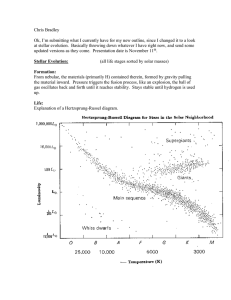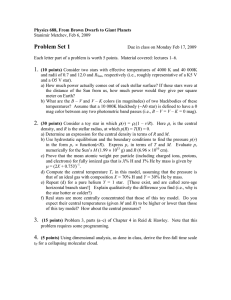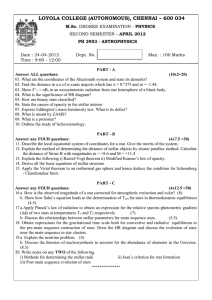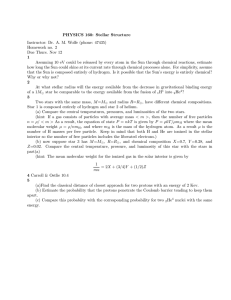Chapter 10 Measuring the Stars
advertisement
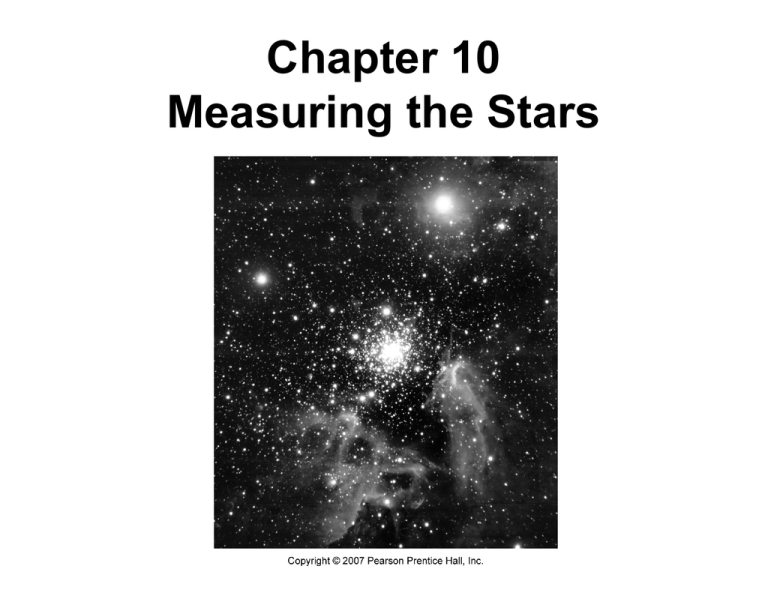
Chapter 10 Measuring the Stars Units of Chapter 10 The Solar Neighborhood Luminosity and Apparent Brightness Stellar Temperatures Stellar Sizes The Hertzsprung-Russell Diagram Extending the Cosmic Distance Scale Stellar Masses 10.1 The Solar Neighborhood Parallax: look at apparent motion of object against distant background from two vantage points; knowing baseline allows calculation of distance 10.1 The Solar Neighborhood Nearest star to the Sun: Proxima Centauri, which is a member of a 3-star system: Alpha Centauri complex Model of distances: Sun is a marble, Earth is a grain of sand orbiting 1 m away Nearest star is another marble 270 km away Solar system extends about 50 m from Sun; rest of distance to nearest star is basically empty 10.1 The Solar Neighborhood The 30 closest stars to the Sun: 10.1 The Solar Neighborhood Barnard’s Star (top) has the largest proper motion of any – proper motion is the actual shift of the star in the sky, after correcting for parallax. The pictures (a) were taken 22 years apart. (b) shows the actual motion of the Alpha Centauri complex. 10.2 Luminosity and Apparent Brightness Luminosity, or absolute brightness, is a measure of the total power radiated by a star. Apparent brightness is how bright a star appears when viewed from Earth; it depends on the absolute brightness but also on the distance of the star: 10.2 Luminosity and Apparent Brightness This is an example of an inverse square law 10.2 Luminosity and Apparent Brightness Therefore, two stars that appear equally bright might be a closer, dimmer star and a farther, brighter one: 10.2 Luminosity and Apparent Brightness Apparent luminosity is measured using a magnitude scale, which is related to our perception. It is a logarithmic scale; a change of 5 in magnitude corresponds to a change of a factor of 100 in apparent brightness. It is also inverted – larger magnitudes are dimmer. 10.3 Stellar Temperatures The color of a star is indicative of its temperature. Red stars are relatively cool, while blue ones are hotter. 10.3 Stellar Temperatures The radiation from stars is blackbody radiation; as the blackbody curve is not symmetric, observations at two wavelengths are enough to define the temperature: 10.3 Stellar Temperatures Stellar spectra are much more informative than the blackbody curves. There are seven general categories of stellar spectra, corresponding to different temperatures. From highest to lowest, those categories are: OBAFGKM 10.3 Stellar Temperatures The seven spectral types: 10.3 Stellar Temperatures The different spectral classes have distinctive absorption lines. 10.4 Stellar Sizes A few very large, very close stars can be imaged directly using speckle interferometry; this is Betelgeuse: 10.4 Stellar Sizes For the vast majority of stars that cannot be imaged directly, size must be calculated knowing the luminosity and temperature: Giant stars have radii between 10 and 100 times the Sun’s. Dwarf stars have radii equal to, or less than, the Sun’s. Supergiant stars have radii more than 100 times the Sun’s. 10.4 Stellar Sizes Stellar radii vary widely:
